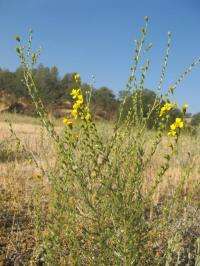Predicting when plants face extinction threat

(Phys.org) -- Drawn to dense stands of wildflowers in search of food, bees and other pollinators carry pollen between plants and provide a vital service for the survival of many plant species.
But human activities can disrupt this mutually-beneficial relationship. Habitat destruction, climate change, and the spread of exotic species can all transform previously abundant plant populations into sparse remnants incapable of attracting pollinators and doomed to spiral into extinction.
Carla Essenberg, a Ph.D. candidate in the Department of Biology at the University of California, Riverside, has developed a mathematical model to predict when plants are at risk of losing their pollinators, which could guide decisions that help prevent extinctions of wildflower species.
Assuming only that flower-visiting insects attempt as quickly as possible to harvest energy in the form of nectar, the model predicts key threshold densities below which plants become much less attractive to pollinators.
Developed at UC Riverside, Essenberg’s model shows that plant species with widely-scattered, inconspicuous flowers are the most likely to lose their ability to attract pollinators as their densities decline.
“This could be a problem because plant species with these traits probably won’t be very attractive to pollinators in the first place and can ill afford to lose the few pollinator visits they normally receive,” said Essenberg, who studied music and philosophy during her undergraduate days at St. Olaf College, Minn., before turning her attention to pollination ecology at UCR.
The model first obtains several estimates: how quickly the pollinators travel between flowers, how much time they need to extract pollen and nectar from a flower, how large their foraging range is, what the flower density outside of the population being studied is, and how dense the pollinator population is. With these estimates, the model then generates a plot showing the relationship between flower density and per-flower visitation rates. Typically, predicted visitation rates drop very rapidly towards low densities, whereas they respond less to flower density at higher densities.
“The model’s predictions provide a starting point for field studies investigating the factors that put plant populations at risk of reproductive failures and ultimately extinction,” Essenberg said.
Study results appear in the August issue of the American Naturalist.
Over the past few hundred years, human activities have increased species extinction rates by as much as a thousand times their previous levels.
“With resources available for rescuing threatened species stretched thin, predicting which species are in the greatest danger could play a vital role in conserving the rich biodiversity we have today for our children and grandchildren to enjoy,” Essenberg said.
Journal information: American Naturalist
Provided by University of California - Riverside










.jpg)








